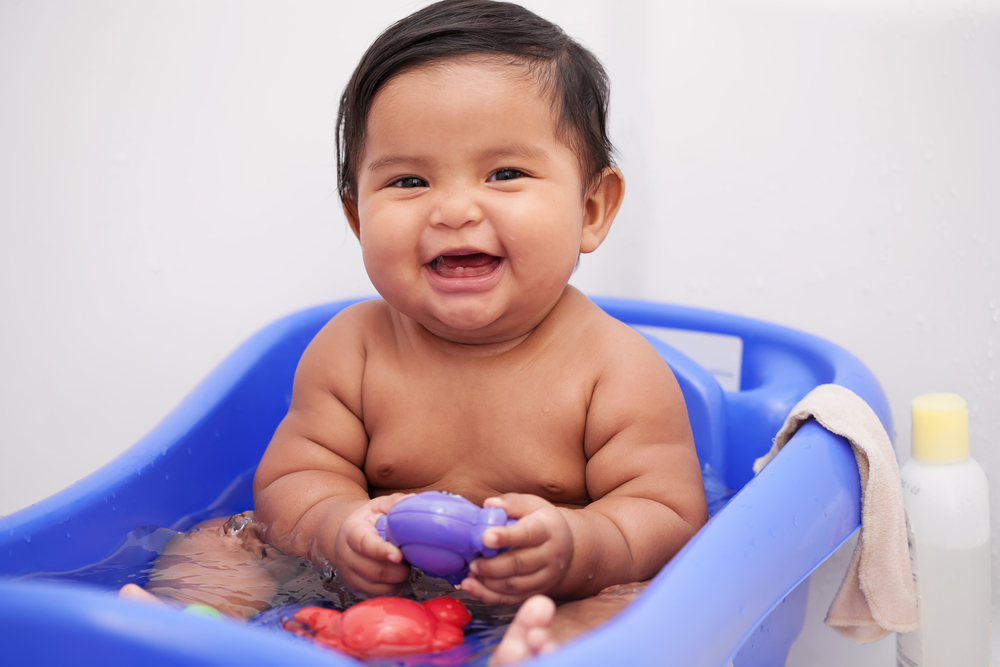
Most newborns protest against taking baths, but before long it will become one of her favorite rituals. She'll probably perk up as soon as she hears the water running, and you'll have a hard time coaxing her out of the tub. In the meantime, here's your reward: There's nothing more delicious than the scent (and sight) of a freshly bathed baby bundled in a towel.
Here are some tips for how to give Baby a bath, from the newborn stage onward.
How to Sponge Bathe a Newborn
Your baby's umbilical cord will fall off about two weeks after delivery. Until then, parents must sponge bathe their newborns. A sponge bath is also necessary if his circumcision incision hasn't yet healed. The American Academy of Pediatrics recommends bathing your newborn about three times per week.
Set everything you'll need within arm's reach—soap, washcloth, cotton balls, towel, diaper, change of clothes—so you can keep all hands on Baby. Start by cleaning the face with damp cotton balls or washcloths. Focus on the eyelids, working from the inside to outside corner, and use a separate cotton ball for each eye. Also clean outside of Baby's ears with a damp cotton swab (avoid sticking the swab in the ear or you risk puncturing the eardrum).
Wash your baby's body with a damp washcloth and a few drops of mild soap. If your baby's hair seems dirty, wet it down using a damp washcloth and the same mild soap.
When you're done bathing him, quickly wrap him up in the towel so he doesn't lose too much body heat. Dry him thoroughly, being sure to get into the creases, before you diaper and dress him.
How to Bathe Baby in an Infant Tub
Once the baby's umbilical cord stump has fallen off, he's ready for a bath in his mini tub. Choose an infant tub that has a contoured design or an internal sling that prevents your baby from sliding. Never use a bath seat—these can tip over when the suction cups fail, trapping your child underwater.
Gather your supplies and fill the tub with a couple inches of warm water. It should be slightly cooler than your ideal temperature, as Baby's skin is more sensitive (aim for around 100 degrees F). Consider setting your water heater to 120 degrees F, so if your baby turns the hot water faucet handle, she won't get scalded.
Gently lower your baby into the tub as you support his head and neck with your arm. Clean his face just like you did when sponge-bathing him, and wash him with mild soap and a washcloth. Don't turn your back on your baby for even a second—babies can drown in just a few inches of water.
Making certain rituals part of bathtime can help your little one's skin stay healthy. Scott Grant, M.D., MPH, FAAP, at Detroit Medical Center's Children's Hospital of Michigan, recommends focusing on cleaning the "rolls" that often develop around babies' necks, arms, and legs. Dirt and dead skin cells tend to accumulate in these areas, which can irritate skin and lead to infections like cellulitis or the worsening of conditions like eczema.
After the penis has healed from circumcision, you can wash it as you would any other part of his body. Clean a girl's genitals by wiping from front to back. Don't use soap in her groin area; it may cause irritation.
Once or twice a week, during his baths, use baby soap or a drop of mild, tear-free shampoo. If he's developed cradle cap (scaly patches that appear on the scalp) loosen the scales with a soft-bristle baby brush while you shampoo.
Once she's clean, pat your baby dry. "Too much time exposed to the air after the bath can cause the evaporation of the moisture from the skin," Dr. Grant explains. Then apply a thick, dye- and fragrance-free hypoallergenic lotion to lock in your infant's much-needed moisture. A 2014 study in the Journal of Allergy and Clinical Immunology showed that daily application of moisturizing lotion in the first 32 weeks of life can reduce the risk of eczema in babies.
American Baby





